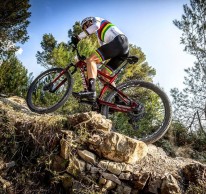The best CORE routine to improve as a cyclist
Without lumbo-pelvic stability there is no efficiency on the bike. Although it is not easy to see a direct relationship between improved performance and CORE work, sometimes it is better to have a session in the gym than to go out on the bike, at least until deficits are covered.

What is CORE?
When we pedal on the bike, the core is responsible for maintaining our posture on it, as well as being the transmitter of the forces exerted by the legs in each pedal stroke.
We can define the CORE as the set of muscles that act as a support center for all the forces we exert with our limbs, and also the one responsible for maintaining our balance and posture when we perform any action.
RECOMENDADO

The best apps for cycling and mountain biking

Black Friday 2025 cycling bargains: save on Garmin, POC, Maxxis and more

Black Friday Garmin 2025: the ultimate guide to choosing your GPS at the best price

Which profile wheels to choose according to the area where you live: mountain, flat or coast

How to wash your cycling clothes? 10 keys to make them always look new

Cycling can help you fight the effects of the time switch

Surely you have seen a colleague who moves his trunk when pedaling, this happens because of a deficit of strength in these muscles. And it causes an unnecessary expense that does not make us go faster, but wasting energy in unnecessary movements.
The advantages of a strong CORE
We have already mentioned that the core muscles allow us to transmit energy to our arms and legs, as well as stabilize the trunk. This will make our movements more powerful and effective, and as a consequence, our athletic performance will be greater.

In the same way, we will get less fatigue, since we will avoid unnecessary work of other muscle groups and this will lead to a lower energy expenditure.
Other advantages of having a well-trained Core are:
- Improvement of body posture
- Improvement of proprioception
- Protection of the abdominal region
- To maintain balance
- Improve the respiratory process
Routine proposal to strengthen the CORE
So that you can implement it today, we are going to propose a routine that you can do without material.
We will perform between 2 and 4 sessions of 15-20 min per week. If possible, do it on days of light cycling or active rest.
The routine consists of 6 exercises that we will perform 2 times in circuit format. We will do 30 seconds of effort and 30 seconds of rest.
1. Plank CLOCK
2. Bicycle
3. Alternate foot lifting plank
4. Wipers
5. Plank touching elbow with knee
6. Climbing plank
How Nino Schurter does it
Nino Schurter, with 10 world titles, 33 World Cup victories, an Olympic gold medal in Rio, plus bronze and silver medals, is clear about the importance of CORE as part of his training routine.
In the following video he explains some of the exercises he does and how we can adapt them at home with less equipment.